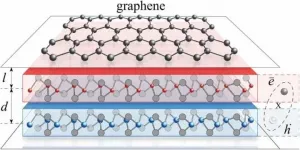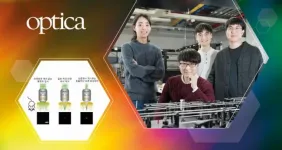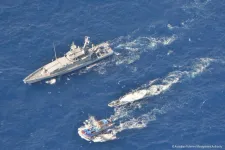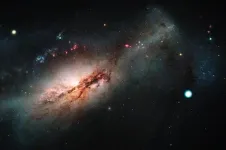New mechanism of superconductivity discovered in graphene
Placing a 2D Bose-Einstein condensate in the vicinity of a graphene layer confers superconductivity to the material
2021-07-14
(Press-News.org) Superconductivity is a physical phenomenon where the electrical resistance of a material drops to zero under a certain critical temperature. Bardeen-Cooper-Schrieffer (BCS) theory is a well-established explanation that describes superconductivity in most materials. It states that Cooper pairs of electrons are formed in the lattice under sufficiently low temperature and that BCS superconductivity arises from their condensation. While graphene itself is an excellent conductor of electricity, it does not exhibit BCS superconductivity due to the suppression of electron-phonon interactions. This is also the reason that most 'good' conductors such as gold and copper are 'bad' superconductors.
Researchers at the Center for Theoretical Physics of Complex Systems (PCS), within the Institute for Basic Science (IBS, South Korea) have reported on a novel alternative mechanism to achieve superconductivity in graphene. They achieved this feat by proposing a hybrid system consisting of graphene and 2D Bose-Einstein condensate (BEC). This research is published in the journal 2D Materials.
Along with superconductivity, BEC is another phenomenon that arises at low temperatures. It is the fifth state of matter first predicted by Einstein in 1924. The formation of BEC occurs when low-energy atoms clump together and enter the same energy state, and it is an area that is widely studied in condensed matter physics. A hybrid Bose-Fermi system essentially represents a layer of electrons interacting with a layer of bosons, such as indirect excitons, exciton-polaritons, etc. The interaction between Bose and Fermi particles leads to various novel fascinating phenomena, which piques interests from both the fundamental and application-oriented perspectives.
In this work, the researchers report a new mechanism of superconductivity in graphene, which arises due to interactions between electrons and "bogolons", rather than phonons as in typical BCS systems. Bogolons, or Bogoliubov quasiparticles, are excitation within BEC which has some characteristics of a particle. In certain ranges of parameters, this mechanism permits the critical temperature for superconductivity up to 70 Kelvin within graphene. The researchers also developed a new microscopic BCS theory which focuses specifically on the novel hybrid graphene-based system. Their proposed model also predicts that superconducting properties can be enhanced with temperature, resulting in the non-monotonous temperature dependence of the superconducting gap.
Furthermore, the research showed that the Dirac dispersion of graphene is preserved in this bogolon-mediated scheme. This indicates that this superconducting mechanism involves electrons with relativistic dispersion -- a phenomenon that is not so well-explored in condensed matter physics.
"This work sheds light on an alternative way to achieve high-temperature superconductivity. Meanwhile, by controlling the properties of a condensate, we can tune the superconductivity of graphene. This suggests another channel to control the superconductor devices in the future.", explains Ivan Savenko, the leader of the Light-Matter Interaction in Nanostructures (LUMIN) team at the PCS IBS.
INFORMATION:
[Attachments] See images for this press release:

ELSE PRESS RELEASES FROM THIS DATE:
2021-07-14
The corona pandemic has ensured that the term "mRNA" is now also known to a large public beyond laboratories and lecture halls. However, the molecule is much more than an important component of a successful vaccine against the SARS-CoV-2 virus. "mRNAs are a central component of all living things on our planet. Without them life as we know it would not function," says Elmar Wolf.
Wolf is a professor for tumour system biology at the Department of Biochemistry and Molecular Biology at the University of Würzburg. With his research team, he has now deciphered new details about the formation of mRNA which provide novel insights into how a fundamental process inside cells works: the transcription. The team ...
2021-07-14
A team of researchers, affiliated with UNIST has succeeded in developing a new optical microscope technology, capable of deeper imaging beyond the biological tissues. This breakthrough has been led by Professor Jung-Hoon Park and his research team in the Department of Biomedical Engineering at UNIST.
Optical imaging technology has emerged as an essential research tool for biomedical studies due to its high resolution and good tomography capability. However, the limited penetration depth of the optical microscope makes it difficult to observe biological tissues of more than 100 μm thickness. This is because strong light scattering, caused by various components ...
2021-07-14
New York, NY--July 13, 2021--The past decade has witnessed scandal after scandal over private images maliciously or accidentally made public. A new study from computer scientists at Columbia Engineering reveals what may be the first way to encrypt personal images on popular cloud photo services, such as those from Google, Apple, Flickr and others, all without requiring any changes to -- or trust in -- those services.
Smartphones now make it easy for virtually everyone to snap photos, with market research firm InfoTrends estimating that people now take more than a trillion photos each year. The limited ...
2021-07-14
A new study reveals the strategies that stop bandits from illegally fishing in Australian waters--but warns there is a cost to the region's poorer countries.
Co-author Dr Brock Bergseth, from the ARC Centre of Excellence for Coral Reef Studies at James Cook University, said poachers are simply following the recurring history of human fishing: intensively fish and devastate local resources, then move further afield to--in these cases--fish illegally or poach in other countries' waters.
"Millions of people rely on fish and seafood and when offered no alternative choice, will chose banditry and illegal fishing ...
2021-07-14
A new method of DNA testing on cocoa beans could revolutionise the chocolate industry, offering consumers greater reassurance about the origins and ethics of their beloved confectionery, and giving the global cocoa industry a precision tool to help end slavery and child labour.
Researchers from the University of Bath, University of the West of England, and Surrey Business School have proven a low-cost method which compares DNA in chocolate products to the cocoa when it is farmed. This means cocoa can be reliably traced back from an individual chocolate bar to the specific farms which cultivated the cocoa in it, a major advance on current fairtrading, certification and sustainability practices.
"This has the potential to ...
2021-07-14
What the fruit fly is to zoologists, the thale cress is to botanists. The widespread herb with the botanical name Arabidopsis thaliana serves them as a model organism from which knowledge can be gained for other plants. It is therefore extremely well researched - also genetically. For example, it is now known that the genetic material of Arabidopsis thaliana (its genome) comprises around 125 million base pairs. It's like having a Lego manual in front of you that is 125 million letters long and contains everything you need to know to build an Arabidopsis plant.
Similar to humans, different Arabidopsis specimens are generally not genetically identical. If you were to compare the construction manual of all plants of this species, you would encounter differences in about 10 million places, ...
2021-07-14
Dr. Iair Arcavi, a Tel Aviv University researcher at the Raymond and Beverly Sackler Faculty of Exact Sciences, participated in a study that discovered a new type of stellar explosion - an electron-capture supernova. While they have been theorized for 40 years, real-world examples have been elusive. Such supernovas arise from the explosions of stars 8-9 times the mass of the sun. The discovery also sheds new light on the thousand-year mystery of the supernova from A.D. 1054 that was seen by ancient astronomers, before eventually becoming the Crab Nebula, that we know today.
A supernova is the explosion of a star following a ...
2021-07-14
A new study co-authored by the UBC Sauder School of Business has found that when senior managers mistreat workers, middle managers often attempt to quietly smooth things over.
Robin Hood was known for stealing from the rich and giving to the poor -- but while he may have lived in Sherwood Forest centuries ago, he would have fit right in as a middle manager in today's business world.
Studies have shown that when employees are mistreated by senior leaders, employees can often get back at them by doing things like gossiping, stealing office supplies or calling in sick when they're well. But according to new research from UBC Sauder, middle managers also get in on the act, and attempt to address workplace injustices by secretly helping out their subordinates ...
2021-07-14
Kamil Gareev, Associate Professor at ETU "LETI," justified the prospects of using magnetotactic bacteria to treat malignant tumors.
LETI researchers identified the main properties of magnetotactic bacteria and described the possibilities of their application in medicine. The results obtained will help create theranostic agents in neurooncology and cardioprotection. The results of the joint study with colleagues from St. Petersburg State University, RAS Institute of Cytology, and RAS Institute of Biotechnology were published as an overview article in the journal Magnetochemistry.
Magnetotactic bacteria (MTB) are distinguished by their ability to synthesize magnetosomes, special cellular organelles in which magnetite biomineralization occurs. Thanks ...
2021-07-14
Autistic people need extra help in going green say researchers behind a new study which argues for a more inclusive environmental agenda.
Climate action movements are gathering extraordinary pace due to international campaigners like Greta Thunberg, whose autism has been well documented. Being autistic has been used to explain and celebrate, but also diminish and denigrate, her activism.
Thunberg, for example, reports that being autistic is a psychological "gift" and "superpower" that underpins her environmental attitudes and behaviours. This has fuelled speculation - in the media and the general public - that autistic ...
LAST 30 PRESS RELEASES:
[Press-News.org] New mechanism of superconductivity discovered in graphene
Placing a 2D Bose-Einstein condensate in the vicinity of a graphene layer confers superconductivity to the material






